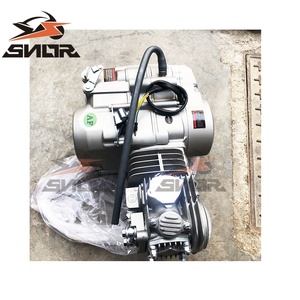(35 products available)





































































































































An oil-cooled engine YX 150cc is a type of bike engine that uses oil to cool its parts so that the bike doesn't overheat. There are different types of the YX 150cc engine, which include:
Single-cylinder four-stroke engine:
The YX 150cc oil-cooled engine has an oil cooling system that helps to maintain a stable temperature of the engine parts. This makes the cooling system very effective. Besides, being a four-stroke engine means that it has an efficient power stroke. Each piston stroke does a different task of intake, compression, power, and exhaust. This results in an even and steady power delivery.
Single-cylinder air-cooled engine:
An air-cooled engine relies on oil cooling to regulate the temperature of the engine parts when they are heated. The oil transfers the heat from the engine parts and then cools it down in a radiator or cooler. The oil-cooling system offers more consistent and precise cooling compared to the traditional cooling method.
Oil cooling system:
The oil cooling system is a key feature in the YX 150cc engine. It helps to maintain the temperature of the engine parts and also offers good performance. The oil flowing through the engine absorbs heat from the engine parts that are heated and then transfers it to a cooler or radiator. The oil cooling system provides a stable and consistent cooling effect.
Cooling:
The YX 150cc oil-cooled engine has a cooling system that is precisely designed to cool the engine parts. The cooling system helps to maintain a stable temperature for the engine parts that are heated. This in turn increases the performance and reliability of the engine.
150cc engine:
The 150cc engine indicates that the engine's displacement is 150 cubic centimeters. The Yx 150cc engine is known for its good performance, which makes it suitable for various uses, such as sports, daily commuting, or off-road riding.
The YX 150cc engine is a very popular choice among bike riders. Before talking about the specifications and maintenance of the YX 150cc engine, it's important to note that there are several variations of the YX 150cc engine.
Oil-cooled engines don't have radiators like water-cooled engines. Oil-cooled engines are best for cooling engines that generate a lot of heat. The cooling system uses oil to cool the engine. The oil flow system cools the heat generated by the engine using oil.
Maintaining the oil cooling system of the YX 150cc engine is crucial for optimal performance and longevity. Follow the steps below to maintain the oil cooling system.
Choosing the right oil-cooled engine YX 150cc requires careful consideration of various factors that align with the intended use, performance expectations, and budget constraints. Here’s a detailed guide on selecting the perfect oil-cooled engine YX 150cc:
Performance Requirements
Determine the performance level needed for specific tasks or activities. Consider factors such as torque, power output, and frequency of use. For high-performance needs, select a YX 150cc engine with superior power output and reliability.
Budget
Establish a budget for purchasing and maintaining the oil-cooled engine. While prioritizing affordability, consider long-term maintenance costs, fuel efficiency, and durability, which may provide savings over time.
Brand Reputation
Choose a reputable brand known for producing high-quality and reliable engines. Research customer reviews and recommendations to understand different brands' reliability and performance.
Application
Consider what the engine will be used for. If it's for a motorcycle, different tuning and performance aspects might be considered compared to using it in a generator or any other application.
Serviceability and Maintenance
Evaluate how easy it is to service and maintain the engine. Select one with accessible components for convenient maintenance and occasional repairs. Regular maintenance is crucial for engine longevity and optimal performance.
Accessories and Parts Availability
Ensure that compatible spare parts and accessories are readily available for the selected engine. This guarantees easy repairs and engine modifications to fit specific needs.
Cooling System
While all YX engines are oil-cooled, some may have better cooling efficiency than others. If the engine runs for long periods, opt for one with a more efficient cooling system to avoid overheating and ensure optimal performance.
Fuel Efficiency
Consider the engine's fuel efficiency, as this will affect operating costs. While the YX 150cc engines are generally fuel efficient, some models may offer better fuel economy than others.
Before any DIY attempt, ensure that the YX 150cc engine permits simple fixes and that the user manual is on hand. The procedures below provide a general overview of how to repair minor issues with the YX 150cc engine.
Q1. How often should the YX 150cc engine be serviced?
A1. Follow the manufacturer's service intervals, usually every 3,000 to 5,000 kilometers, depending on usage and oil type.
Q2. Can the YX 150cc engine be modified for more power?
A2. Yes, but modifications should be done considering reliability and cooling capacity. Consult with experts for safe tuning.
Q3. What is the expected lifespan of the YX 150cc engine?
A3. With proper maintenance, the YX 150cc engine can last 150,000 to 200,000 kilometers or more, depending on various factors.
Q4. What should be done if the engine overheats?
A4. Stop riding, allow it to cool, and check the cooling system. Overheating can damage the engine and needs immediate attention.
Q5. Is it okay to use non-genuine spare parts for the YX 150cc engine?
A5. While it is more cost-effective, genuine parts ensure reliability. Non-genuine parts may vary in quality and fit.